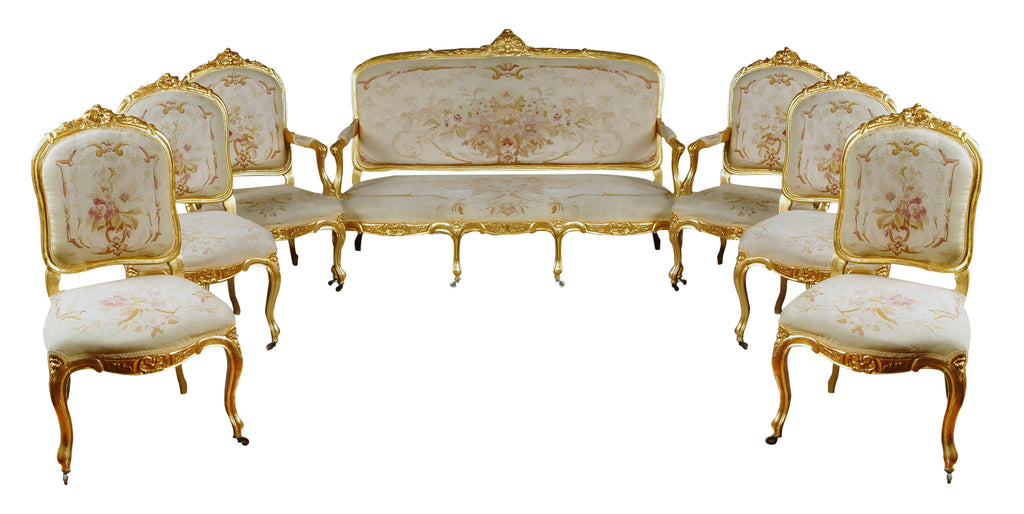A LUXURIOUS FRENCH 7-PIECE AUBUSSON TAPESTRY PARLOR SET
$26,000.00
The description paints a picture of a luxurious and elegant 7-piece parlor set from the French Napoleon III period in the opulent Louis XV style. Crafted from carved giltwood, this set exudes richness and sophistication.
Comprising a Canape, four side chairs, and two armchairs (Fauteuils), each piece is adorned with an oval back, padded arms, and rests gracefully on cabriole legs, showcasing the quintessential Louis XV design elements.
The upholstery, done in handwoven Aubusson Floral Tapestry, adds a lavish touch to the set. The fine Aubusson tapestry is adorned with beautifully crafted floral sprays, elevating the aesthetic appeal of each chair. This exquisite tapestry work, known for its intricacy and artistry, complements the giltwood frames, creating a harmonious ensemble that epitomizes luxury and style.
Overall, this 7-piece parlor set is a testament to the elegance and refinement of the Napoleon III period, combining the ornate Louis XV style with fine craftsmanship and sumptuous upholstery, making it a coveted and stunning addition to any sophisticated interior space.
France, Circa 1870
Dimensions
Canape
Height: 40" (101 cm)
Width: 63" (160 cm)
Depth: 24" (60 cm)
Arm Chairs
Height: 38" (134 cm)
Width: 17 1/4" (43 cm)
Depth: 17 3/4" (44 cm)
Chairs
Height: 40" (101 cm)
Width: 25.5" (64 cm)
Depth: 21.5" (54 cm)
Aubusson tapestry
The origins of tapestry remain mysterious.According to the legend, the Saracens, after they were defeated in the Battle of Poitiers in 732, would have settled weaving looms on the banks of the Creuse river.
The 15th century witnessed the apparition of mille-fleurs: the backgrounds of tapestries were laden with flower patterns - the most famous example being The Lady and the Unicorn.
By the 16th century, tapestries were being woven in Aubusson, Felletin, Bellegarde… They were intended as decoration and drew their inspiration from religious and mythological themes, depicting verdure sceneries, animals and characters.
In the 17th century, tapestry enjoyed a remarkable expansion and in 1665, Aubusson was given the status of Royal Manufacture by Colbert.
After the French Revolution, the workshops of the county of the Marche lost their status of State Manufactures. Upholstery and machine-made carpets replaced wall tapestry, which was no longer appreciated.
At the end of the 19th century, the creation of the École Nationale des Arts Décoratifs d'Aubusson (Aubusson National School of Decorative Arts) sparked a revival of tapestry through changes in its technique: the painter simplifies the weaving process by limiting the number of colours, while avoiding excessive gradations. However, tapestries were still reproductions of paintings.
Only from 1930, with Elie Maingonnat - whose goal was to interest the artists in tapestry -, did painters start to make models exclusively for weaving (Lurçat, Gromaire, Picart-le-Doux, Saint-Saëns).












